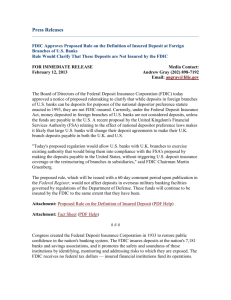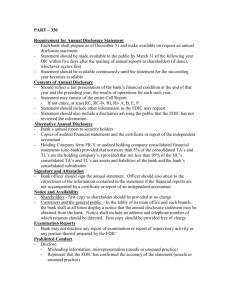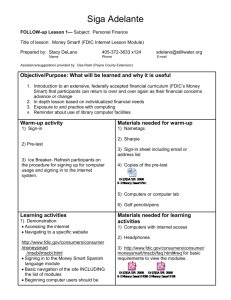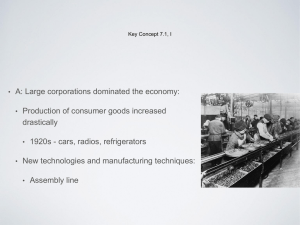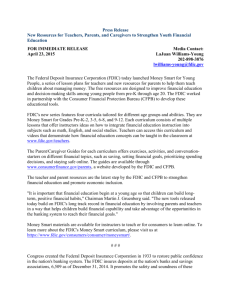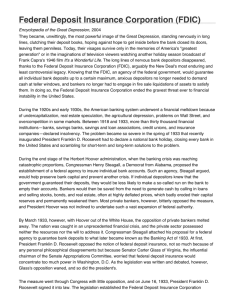Comments/Legal ESS Federal Deposit Insurance Corporation
advertisement
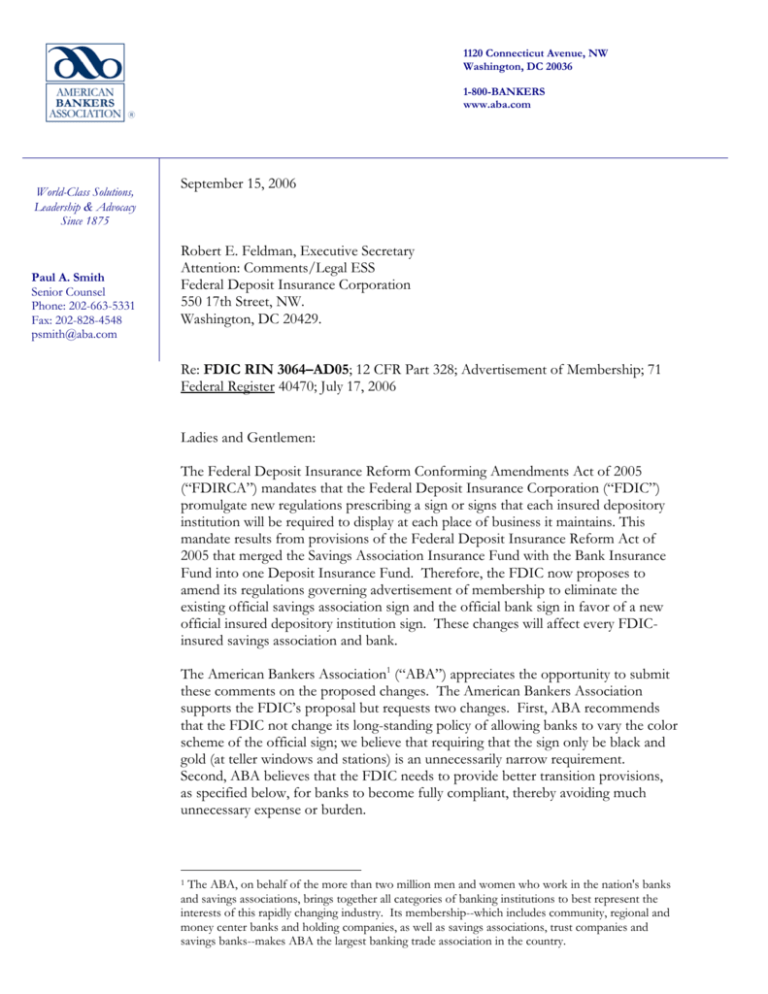
1120 Connecticut Avenue, NW Washington, DC 20036 1-800-BANKERS www.aba.com World-Class Solutions, Leadership & Advocacy Since 1875 Paul A. Smith Senior Counsel Phone: 202-663-5331 Fax: 202-828-4548 psmith@aba.com September 15, 2006 Robert E. Feldman, Executive Secretary Attention: Comments/Legal ESS Federal Deposit Insurance Corporation 550 17th Street, NW. Washington, DC 20429. Re: FDIC RIN 3064–AD05; 12 CFR Part 328; Advertisement of Membership; 71 Federal Register 40470; July 17, 2006 Ladies and Gentlemen: The Federal Deposit Insurance Reform Conforming Amendments Act of 2005 (“FDIRCA”) mandates that the Federal Deposit Insurance Corporation (“FDIC”) promulgate new regulations prescribing a sign or signs that each insured depository institution will be required to display at each place of business it maintains. This mandate results from provisions of the Federal Deposit Insurance Reform Act of 2005 that merged the Savings Association Insurance Fund with the Bank Insurance Fund into one Deposit Insurance Fund. Therefore, the FDIC now proposes to amend its regulations governing advertisement of membership to eliminate the existing official savings association sign and the official bank sign in favor of a new official insured depository institution sign. These changes will affect every FDICinsured savings association and bank. The American Bankers Association1 (“ABA”) appreciates the opportunity to submit these comments on the proposed changes. The American Bankers Association supports the FDIC’s proposal but requests two changes. First, ABA recommends that the FDIC not change its long-standing policy of allowing banks to vary the color scheme of the official sign; we believe that requiring that the sign only be black and gold (at teller windows and stations) is an unnecessarily narrow requirement. Second, ABA believes that the FDIC needs to provide better transition provisions, as specified below, for banks to become fully compliant, thereby avoiding much unnecessary expense or burden. 1 The ABA, on behalf of the more than two million men and women who work in the nation's banks and savings associations, brings together all categories of banking institutions to best represent the interests of this rapidly changing industry. Its membership--which includes community, regional and money center banks and holding companies, as well as savings associations, trust companies and savings banks--makes ABA the largest banking trade association in the country. Specific Comments Section 328.1—Official Sign The proposed official sign would be seven inches by three inches in size, with black lettering and gold background. While similar to the existing signs, the new sign will read ‘‘Each depositor insured to at least $100,000’’ instead of ‘‘Each depositor insured to $100,000.’’ This reflects the increase in deposit insurance coverage of certain retirement accounts up to $250,000. The proposed sign includes the FDIC’s Internet website and leaves out the FDIC seal. Finally, the full faith and credit statement required by the FDIRCA Act is in italics on the left side of the proposed sign and is bordered by a semi-circle of stars. The proposed revision would allow an insured depository institution to vary the size, color, and materials of the official sign at its expense (as is the case now with the current regulation) and to display such altered signs within the institution at locations other than those where insured deposits are received. However, the official sign provided by the FDIC would adhere to the specifications above, and only the official sign could be displayed at windows and stations where insured deposits are routinely received (as is the case now with the current regulations). ABA supports these proposed changes except in one particular. The current regulation does not require that official signs located where deposits are routinely received must be in black and gold colors,2 but the proposed regulation will require that these particular signs must be in black lettering with gold background. ABA believes that this change is unnecessary and may be confusing to bank customers. Some banks have developed specific branding programs, including specific logos and color combinations, that they have now for over a decade used in their institutions, including matching FDIC-insurance signage. This proposed change would force them to have different FDIC-insurance signs in their branches: gold and black signs at teller windows and differently colored signs on lobby doors, windows and advertising brochures, which could be confusing to their customers. The FDIC does not provide any reasons for this change in its long-standing policy allowing such color differences, and the change is NOT required by the statutes. Therefore, ABA urges the FDIC not to make this unnecessary change from current regulatory practice, but instead continue its policy of allowing banks to use alternative color schemes for the FDIC sign. Section 328.2—Display and Procurement of Official Sign The FDIC also proposes to rewrite the current regulation to make these changes and to make it clearer to read. For example, section 328.2 for banks and section 328.4 for savings associations are identical but for the prohibition on savings associations from using the bank sign. Since the law FDIC Advisory Opinion No. 92-15. “Official FDIC Sign Need Not be Black on Gold, But Text and Symbol Must be Same Color,” April 1, 1992. 2 requires that savings associations and banks now use the same sign, these sections are combined into the new section 328.2. Additionally, the current regulation uses both “automatic service facilities” and “remote service facilities.” Since these terms are identical in meaning, the FDIC rewrites the proposed regulation to use only “remote service facility.” ABA believes that this is clearer and supports the change. Section 328.3—Official Advertising Statement Requirements Current section 328.3 requires insured banks to include the official advertising statement in all their advertisements (with certain exceptions). The basic form of the statement is ‘‘Member of the Federal Deposit Insurance Corporation,’’ which may be shortened to ‘‘Member FDIC.’’ However, there is no equivalent requirement for insured savings associations. The FDIC proposes to revise section 328.3 to require all insured depository institutions to include the official advertising statement in their advertisements. The FDIC believes that “consistent treatment of banks and savings associations on this matter would significantly enhance the public’s ability to determine whether an institution’s deposits are federally insured or not, and it would eliminate any possibility for public confusion.”3 ABA agrees with the FDIC’s reasoning and supports this change. ABA notes that there has been no prohibition on savings associations using “Member FDIC” in their advertising and it appears that most already do so. The FDIC proposes to simplify the advertising requirements by reducing the number of exceptions to five. There are currently twenty exceptions to the required use of the official advertising statement. The proposed rule does this by limiting the applicability of section 328.3 to advertisements that specifically promote deposit products or generally promote banking services offered by an insured depository institution. These would include advertisements that contain an institution’s name and a statement about the availability of general banking services (as general banking services include depository services). The term “advertisement” is defined as a commercial message, in any medium, that is designed to attract public attention or patronage to a product or business. By limiting the applicability of section 328.3 in this way, the FDIC concludes that most of the current exceptions to the advertising requirements become unnecessary. The FDIC also is eliminating three exceptions that occur so infrequently as to appear to be unnecessary. ABA concurs, and supports the proposed changes. Section 328.4—Prohibition Against Receiving Deposits at Same Teller’s Station as Noninsured Institution This is a current regulatory requirement, but the FDIC is moving it from section 328.2 to this new section on the grounds that it is not actually an advertising provision and deserves to be separated from the advertising requirements. ABA does not object to the proposed change. Additional Questions Transitional Provisions: The final rule would be effective six months after publication in the Federal Register. The FDIC solicits comment on whether the proposed effective date would give insured depository institutions sufficient time to adjust to the new requirements. ABA has received no comments from bankers that this is too short a transition period. However, bankers have raised two concerns about the transition provision. First, the FDIC does not provide any period of parallel effectiveness. As a result, the bank or savings association cannot display the new signs until the effective date, and then the insured institution must display the new signs as soon as the regulation is effective. This results in every bank and savings association having to switch all of its signs in the lobby and teller areas overnight 3 71 FR 40441. before the day the regulation becomes effective. Instead, the FDIC needs to provide that there will be a 60- or 90-day period around the effective date in which banks may have either sign on display without being in violation of either the prior or the newly-adopted regulation. Second, ABA would like the FDIC to provide that banks and savings associations may continue to hand out existing stocks of advertising brochures, lobby brochures, and similar printed materials until such stocks are exhausted. This would prevent a compliance violation, for example, if a bank or savings association had already distributed a stock of such brochures to third parties to hand out to potential customers, and this stock was not exhausted by the effective date of the new regulation. Non-deposit product restrictions: The FDIC also asks whether the final rule should include a provision that would: (1) prohibit use of the official advertising statement in advertisements relating solely to non-deposit products or hybrid products containing non-deposit product and deposit features (e.g., sweep accounts); and (2) require that the official advertising statement be clearly segregated from information about non-deposit products in advertisements containing information about both non-deposit products and insured deposit products. ABA believes such additional provisions are unnecessary. Existing regulations on consumer protections on bank sales of insurance already work in the insurance non-deposit product arena. Existing guidance on website construction also prevents customer confusion between deposit and non-deposit products. And there is long-standing guidance on separation of deposit and non-deposit products in the area of securities sales and other non-deposit products. ABA is not aware of any complaints from customers about confusion between deposit and non-deposit products, but if the FDIC has reason to believe that confusion occurs, then ABA would rather see the FDIC propose this prohibition in a separate rulemaking. Conclusion ABA appreciates the opportunity to file comments on the FDIC’s proposed changes to the advertising of membership. ABA supports the proposed changes with two recommendations for changes. First, ABA sees no reason for the FDIC to change its long-standing allowance of banks and savings associations to use a different color scheme for the FDIC official sign, and urges the FDIC to retain the existing policy of allowing banks to use signs other than black and gold at the teller windows and stations. Second, ABA requests that the FDIC improve the transition provisions to allow banks and savings associations (a) to have either signage in use for a reasonable period of time to allow orderly changing of the signage and (b) to exhaust already printed supplies of brochures, advertising flyers and similar paper-based advertising rather than require that the depository institution to institute a search and destroy mission for every remaining brochure or flyer that might be already distributed. If the staff of the FDIC has any questions about these comments, please call the undersigned. Sincerely, Paul Smith Senior Counsel
